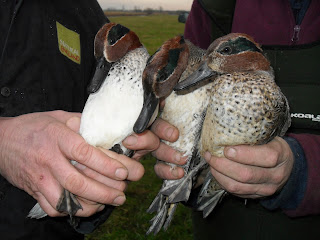The last few days have seen very few Wigeon caught and instead a good number of Teal, 34 since Thursday! These have been mainly from the duck trap at North Duffield and the whoosh net at Wheldrake.
Today (Monday 19th) Wheldrake & the Top Pond at North Duffield were both frozen again but 5 new Teal were in the duck trap on the Top Pond island. A few photos were taken to show the comparison between the adult and juvenile male birds, although darkness was fast approaching so they’re not the best quality!
The adult male is on the left and the two juvenile birds are middle and right. The adult bird had a very white breast compared to the browny coloured juveniles.
One adult (left) with two young male Teal
Along with looking at the breast and tails, the feathers on their back (shown below) can separate the adults and juveniles, which still have a lot of brown feathers and are yet to gain their full adult plumage.
Showing the contrast
There were hundreds of birds on the river so a whoosh net was rigged up this afternoon on the banking, Craig had started to grain it up on Saturday so we hope to get a catch in this week!
At the weekend Mike had a few more birds to add to the totals. Yesterday (Sunday 18th) both Wheldrake & the Top Pond were still frozen over, 3 new Teal were in the duck trap at North Duffield early in the morning, then a check again in the afternoon found another 3 new Teal plus a Mallard & Wigeon.
Saturday (17th) both pools were frozen over so no birds were around although approximately 1500 Wigeon/Teal were on the river. Two more Teal were in the duck trap at North Duffield.
On Friday (16th) Craig & Mike checked Wheldrake early am, lots of birds were on the pool but there was nothing in the area to fire on. A visit to the Top Pond at North Duffield found just the one Teal in the duck trap. Late afternoon Mike, Fal & Lucy headed to Wheldrake to try for a catch, there were hundreds of birds on the pool on arrival (around 4pm), mainly Wigeon and Teal, along with a couple of Pintail and Curlew. A flock of Lapwing dropped in low down, gliding over the whoosh net! Nothing was in the area on arrival but after a 45 minute wait a few Teal made their way up to the grain, so it took awhile but the net was eventually fired just as daylight was fading! Had to extract by torchlight! A catch of 15 Teal, well worth the wait!
Thursday (15th) Craig headed to Wheldrake early am, there was nothing in the area but a few birds on the pool. Moving on from Wheldrake a check of the duck trap at North Duffield found 5 new Teal! Late afternoon (just before dark) Craig & Fal headed back to Wheldrake, hundreds of birds were on the pool including 10 Curlew. After a bit of a wait they eventually fired on a few Canada & 4 Mallards. The geese escaped leaving them with just the 4 ducks to ring!






















